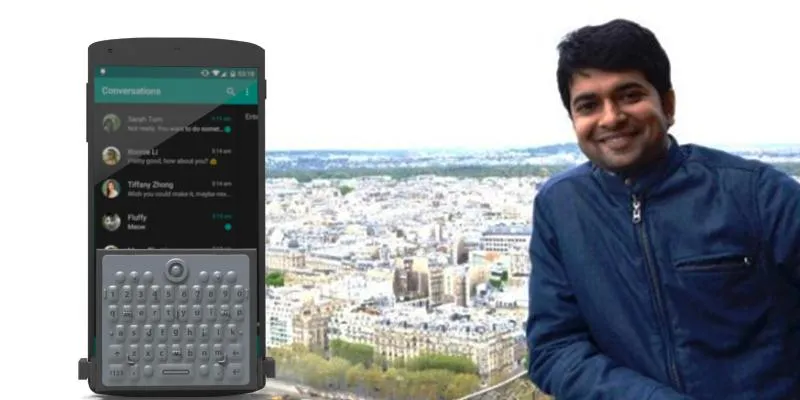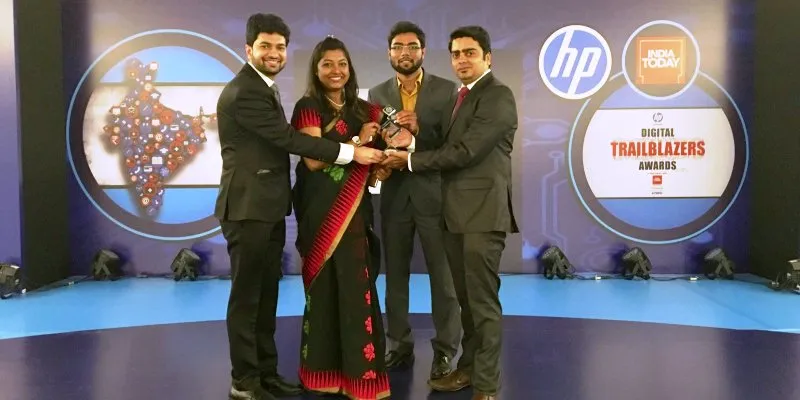GingerMind Technologies’ Eye-d is tapping technology to empower the visually impaired
Launched in 2016, Eye-d is an AI-based app that functions as a companion to the visually challenged and helps improve the quality of their life.

The value of an idea, they say, lies in its execution and use. Keen to improve the life of the visually challenged, a team of four people came together to set up Bangalore-based GingerMind Technologies. Today, they have used that one idea to bring change to the life of the visually impaired.
They launched Eye-d, an artificial intelligence-based application that provides assistance to the visually impaired. They conceptualised the app as a standalone solution to improve the quality of life of the visually impaired (VI) and to serve as a companion for their daily needs.
The usability of the app is supported by a keypad that can be attached to smartphones. Currently, the app is available in a paid and unpaid version.
Gaurav Mittal started working at Citrix, Bangalore, after graduating from IIT-BHU. In 2012, during one of Citrix’s CSR days, Gaurav visited the National Association for the Blind where he observed visually impaired people and pondered about ways in which existing technologies could be leveraged to make day-to-day functioning easier for them. He noticed that while some people did not own a smartphone, others who had it could not use it to its full potential.
Gaurav started forming groups within his company and outside to brainstorm and discuss the possibility of an authentic solution. Between 2012 and 2014 these groups developed seven hardware prototypes that performed different functions such as reading texts, enabling the user to know his/her location and knowing the elements of their environment.
In 2014, the team received funding from Microsoft, Citrix and Intel with which they established their startup, GingerMind Technologies. The prototypes were discarded as launching them would escalate costs.
Funding has been a source of struggle for the bootstrapped company, Gaurav says. Providing users with technical support has also been a challenge they have overcome. Their current support system is managed by the team and provides assistance through phone calls and chat in 15-plus languages.
If a person wants to chat, s/he can type a message in the language they know using Eye-d’s keypad, after which the translation system built in the admin dashboard translates the message into English for the support team to comprehend. The support team’s reply is read out loud to the user.

Marketing the application
The power and originality of their product ensured that the company has an unbeatable marketing expenditure – Rs 0.
After the application was launched, a few NGOs and non-profits voluntarily started forming teams to train people on usage. They got in touch with Gaurav and his team to give feedback.
“Our marketing is taken care of by word of mouth and media mentions. Another interesting feature about the visually challenged community is that anything of interest to them is passed on to people in other cities very quickly,” he adds.
The team launched a paid app in March 2017.
For this, they consulted a sample set and told them that in order to sustain and add more features to their app the users will have to pay.
Gaurav says most people happily conceded.
“They were happy to pay for something useful to them,” he said. The app was launched at a price point of $1.50; it has now reached $3.50 (Rs 280) with over 1,000 paid users.
Within 5-6 months after the launch, Eye-d started trending among the visually impaired, nationally and internationally. The app is now being used by over 8,000 visually challenged people from over 160 countries.
Features and functions of the product
The application Eye-d is currently available for all android phones; an iOS version will be launched soon.
Android phones have Talk Back, a pre-existing feature that helps individuals who are visually impaired or have low vision navigate the phone easily. A person can use the feature by turning it on under the “Accessibility” tab in the phone settings. The feature reads out the text under the finger as the user explores the phone screen.
Eye-d has leveraged this feature and collated the functions of different applications in one. The app offers different options for a blind person to know where they are, what their surroundings constitute of, navigate places of interest and read out printed texts.
Eye-d started out by testing and carrying out research with the help of 10 visually challenged people in Bangalore who already owned a smartphone and were using the accessibility feature.
The team is currently in the middle of launching hardware in the form of a keypad that can be attached to a user’s smartphone. This keypad will be equipped with a joystick and buttons that will respond to tactility, and separate ones to accept and reject calls. While Gaurav and his team will work on the software; the hardware is taken care of by four companies. These partnerships will help strengthen networking and execute future ideas easily.
“It helps keep our burn rate low and deliver ideas in a cost-effective manner,” Gaurav adds.
The companies include Techvision, a Pune-based company run by visually impaired people. Techvision has helped them refine the idea and introduced them to various marketing channels.
The keypad will be priced at $60; orders worth $180,000 have already been received. As soon as fresh funding comes in, processing of these orders will begin.
GingerMind has created an online petition to urge the state government and corporate bodies to support their venture. They are also expecting some funds from the Karnataka Government after they were chosen to be part of Elevate 100, an initiative for startups.







